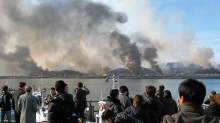 New Focus on North’s Food Shortage
New Focus on North’s Food Shortage
New Focus on North’s Food Shortage
By ALAN COWELL and MARK McDONALD
Published: November 24, 2010
PARIS — As outsiders from Beijing to Washington struggle to see a pattern in the secretive dynamics of the North Korean leadership, one part of the tangled puzzle seems beyond dispute: the country’s 25 million people cannot feed themselves and face acute food shortages as they have done for many years.
But that has not prevented — and indeed may have encouraged — the regime in Pyongyang in actions such as Tuesday’s shelling of a populated South Korean island or a weekend disclosure concerning what seems a new and ambitious effort to reactivate North Korea’s nuclear enrichment program.
Just last month, South Korea resumed aid shipments of rice and instant noodles for the first time since early 2008 as part of an $8.5 million package that, though largely symbolic in relation to the crushing food shortages, was seen as the result of diplomatic overtures by the North in response to its economic plight.
“It could be the starting point of a new chapter in inter-Korean relations,” Choi Jin-wook, a North Korea expert at the Korea Institute for National Unification in Seoul, said at the time.
Such hopes seem to be drowned out Tuesday by the thunder of artillery barrages.
“They’re in a desperate situation, and they want food immediately, not next year,” Mr. Choi said on Wednesday. “Food is the No. 1 issue.”
Others used harsher terms.
“This incident seems to fit the pattern of a Mafia shakedown,” said Tim Peters, a longtime resident in Seoul and head of Helping Hands Korea, an nongovernmental organization that works with North Korean defectors. “It’s a Mafia extortion by the Kim regime. And it has worked for them before: It’s the feed-us-or-we’ll-shoot-you approach. And now with winter coming on, they’re trying to get more food aid.”
“The regime wants just enough food to keep the population from turning.”
Just days before the shelling, a joint report by two United Nations agencies — the World Food Program and the Food and Agriculture Organization — said that, despite a relatively good autumn harvest, North Korea remained in acute need of food, especially for its youngest children, pregnant women and the elderly.
Around one-fifth of the 25 million population would continue to face food shortages, the report said. So critical was the situation that North Korea was short of around half a million tons of food and government hand-outs were inadequate.
Rations provided by the government through its Public Distribution System “would likely contribute about half the daily energy requirements,” the report said, leaving many citizens to eke a living from black market food supplies or modest plots and gardens.
“A small shock in the future could trigger a severe negative impact and will be difficult to contain if these chronic deficits are not effectively managed,” said Joyce Luma, the head of the World Food Program’s Food Security Analysis Unit who was a co-leader of a mission to North Korea in September.
The report said that between now and next October, North Korea would need to import an estimated 867,000 tons of food. The government plans to buy around 325,000 tons, leaving 542,000 tons as a shortfall. The two United Nations agencies recommended providing 305,000 tons in international food assistance to the most vulnerable population.
Battered by severe floods, North Korea’s own agricultural sector — which the report called “the main contributor to the national income” — showed an increase in staple food production of only three percent in the current year compared to the previous year. The country’s main crops are unmilled rice followed by corn, potatoes, wheat and barley and soybeans.
Alan Cowell reported from Paris, and Mark McDonald from Seoul.
